This week, the last of the year, I have decided to dedicate to Champagne. Here is another article chronicling one of my recent experiences centered around the wine chosen by many to celebrate the New Year.
I mentioned last month that my family will soon be moving to Houston. From what I have been able to ascertain, the move will be beneficial from a wine standpoint–it could not be any worse than living in the state with the most restrictive wine laws in the country.
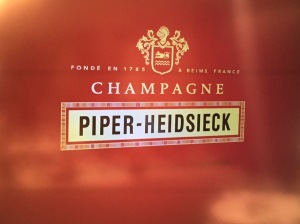 There is one large advantage of living here in Philadelphia however: its rather close proximity to New York City. It seems like just about every week there are at least a couple of wine tastings to attend in New York, and they further multiply in the Fall. All told, I imagine I have been up the I-95 corridor a couple dozen times for tastings, but none were more impressive than the three events I attended over the course of 24 hours in November.
There is one large advantage of living here in Philadelphia however: its rather close proximity to New York City. It seems like just about every week there are at least a couple of wine tastings to attend in New York, and they further multiply in the Fall. All told, I imagine I have been up the I-95 corridor a couple dozen times for tastings, but none were more impressive than the three events I attended over the course of 24 hours in November.
The first was a tasting of vins clairs held by the Chef de Cave of Piper-Heidsieck, Régis Camus, who has been named Sparkling Winemaker of the Year a whopping eight times (with seven of those being consecutive).

I usually sit in from at tastings so I can catch everyone in the crowd….
The champagne process is fairly complex: First still wines are produced from the scores of vineyard sites from around the Champagne region. These “vins clairs” are then blended, often using wines not only from three different grapes (Chardonnay, Pinot Noir, and Pinot Meunier) from all over the Champagne region, but most Champagne houses use vins clairs from different vintages that have been held in reserve for precisely this process.
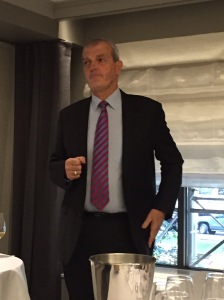
Régis Camus
The blended wines are then bottled with a small amount of yeast and sugar (the liqueur de tirage), which results in a second fermentation in the bottle, creating the bubbles (the prise de mousse). After some time sur lies, the dead yeast cells are gathered in the neck of the bottle (by the process of riddling or rémuage) and removed (dégorgement). A small amount of wine and sugar is once again added back into the champagne (dosage), with the amount of sugar this time determining the style of champagne (e.g., Extra Brut, Brut, Sec, Demi-Sec, etc.).
In all my travels through the wine regions of the U.S. and Europe (and in particular Champagne), I had only had the opportunity once before to taste vins clairs, at a spectacular tasting at Mumm Napa in California, just a few months before.
With all due respect to the fine people at Mumm Napa, the Piper-Heidsieck tasting was unique (notice I did not say “really unique,” “quite unique,” or even worse “even more unique”–it is either unique or it is not, plain and simple).
Régis walked us through the tasting of the vins clairs while simultaneously explaining the champagne process and his personal approach to blending and making what I consider the elixir of the gods.
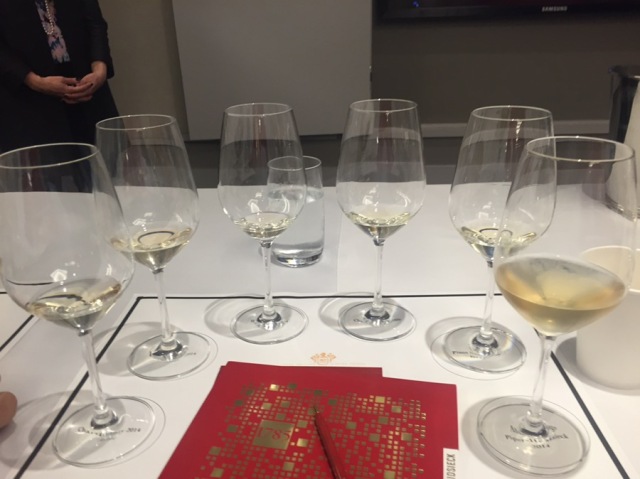
Vins clairs
We started with three vins clairs from the 2014 vintage:
2014 Chardonnay Avize (Grand Cru): Bright and fresh with grapefruit, honey, and minerality. Sharp and vivacious. This wine was used mostly for 2014 vintage wines but some was held as a reserve wine, which will go into the N.V. Brut in 4-5 years.
2014 Pinot Noir Verzy (Grand Cru): Makes up a large percentage of the N.V. Brut. Brings fruitiness and backbone, tension, and structure. A bit of citrus with apple. A little fatty which was a characteristic of 2014 according to Régis. Also used for vintage and reserve. Not as bracing of a finish as the Chardonnay.
We then moved on to the Pinot Meunier, a variety which Régis described as “very champenois.” While Pinot Noir and Chardonnay are more glamorous, Régis said he would not be able to do his job without Meunier as it brings fruit to the wine. It is rare to keep Meunier en réserve, but when he does, it is always blended with Chardonnay or Pinot Noir first so that it will hold its freshness. Additionally, vintage champagnes (at least at Piper) do not contain any Pinot Meunier since Chardonnay and Pinot Noir are more structured and can hold up better over time.
2014 Pinot Meunier Ecueil: Close to Reims. Régis loves this area which produces a “crunchy” Meunier. Fruity, like biting into a crunchy apple or pear.
Régis then encouraged us to revisit the three wines, describing Chardonnay as the Orange Juice in the morning, Pinot Noir as the wine you have with dinner and Meunier as the fruit juice you have in the afternoon. The description brought a few chuckles from those in attendance, but I thought it was a brilliant description of the final product as well: Chardonnay brings acidity and finesse, Pinot Meunier adds fruit and floral aspects, and Pinot Noir adds structure and depth.
We then moved on to the reserve wines, the vins de réserve, which are held because they are exceptional wines. Régis likened reserve wines to a library, which he references only when a blend is lacking in a certain areas. While he stated that some are reluctant to access those wines in the library (not wanting to “waste” the wines in reserve), Régis stressed that such reluctance would end up hurting the current blend. If the blend needs a reserve wine, then it gets it, period.
Regis brought along vins clairs from the same vineyards as the 2014s above. Piper still has plenty of reserve wines from the ’08 and ’09 vintages as they were stellar years in Champagne (much more so than ’10 and ’11, for example, when practically no vins clairs were held in reserve).
2009 Chardonnay Avize (Grand Cru): Color is virtually the same as the ’14 with a more pronounced minerality. Still very fresh and has a huge potential for aging. Softer and rounder than the ’14 with candied citrus. Whoa. This wine was a stunner on its own. While I certainly love the final product (a bottle of Piper-Heidsieck champagne), I would love to have a case of this reserve wine in my cellar.
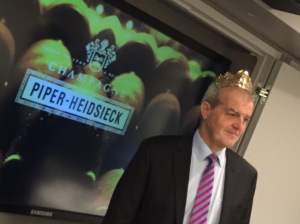
Things got a little crazy during the walk-around tasting with Régis donning the tiara from the bottle of Piper-Heidsieck Rare.
2008 Pinot Noir Verzy (Grand Cru): Again, similar color to the ’14, but with a much more expressive nose. If tasted blind this could easily pass as a Chardonnay. Fresh and precise. Structured and muscular. This gets a Whoa as well.
The last vin clair we tasted was the actual blend that made up the 2014 blended non-vintage Brut:
2014 Blended Wine: 90% 2014 wines and 10% reserve wines. 55% Pinot Noir, 15% Chardonnay, 30% Pinot Meunier. More than 100 different vins clairs were blended to make this wine. Darker than any of the other wines since it had not been stabilized and it had been through a lot of blending and travel. Tasting the wine, you can really see how it all comes together. The finesse and acidity of the Chardonnay, the structure of the Pinot Noir, and the “crunchiness” (Régis’ favorite word) of the Pinot Meunier.
This incredible vins clairs tasting was followed by a walk around tasting of most of the current Piper-Heidsieck releases, which I will address in Part Two….

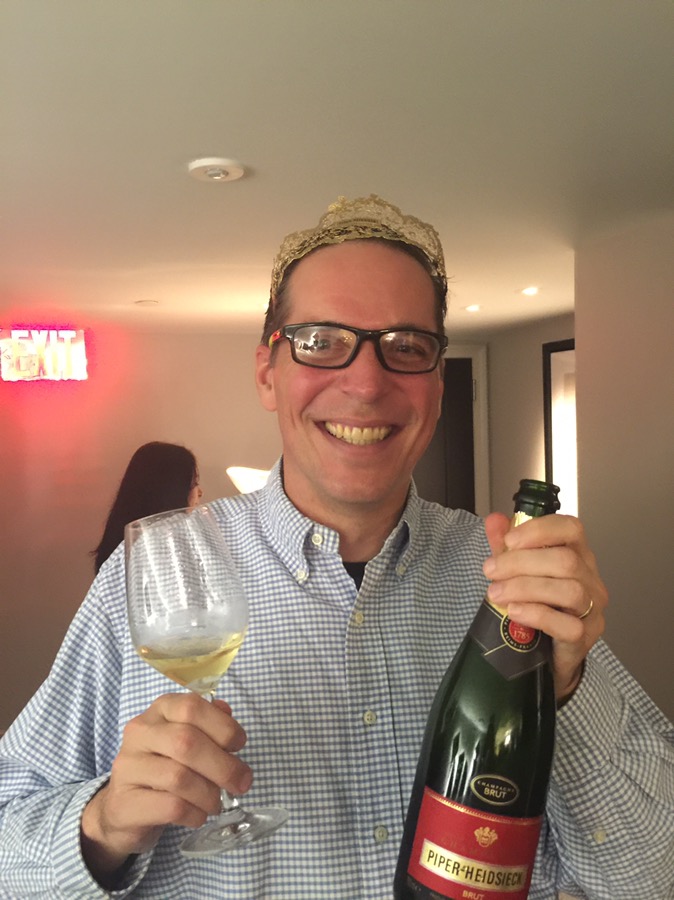







Oh wow! This looks like so much fun! You are lucky to be in such close proximity to NYC. We don’t have many wine tastings at all in my city…maybe about only twice a year, and it’s usually just a gathering of drunken fools. Sigh. Good luck on your move and a very Happy New Year!
LikeLiked by 1 person
The tasting that day was great, but what followed was even more fun:
LikeLiked by 1 person
How funny it is that we both decided to post about almost two month old event on the same day? Very good summary – I took much lesser amount of notes, but more pictures 🙂
LikeLiked by 1 person
I saw that! I guess it is just that bubbly time of year! A few more pictures for me on today’s post….
LikeLiked by 1 person
What a tough job!
LikeLiked by 1 person
Grueling….
LikeLiked by 1 person
Awesome! I will have to give these selections a try 🙂 Looks like you had a great time!
LikeLike
All of them are great options….
LikeLike
Would have loved to be there tasting champagne (definitely the nectar of the Gods)! How do you find out about these kinds of tastings? As you know, not much of it happens in good ole PA.
LikeLiked by 1 person
There is the occasional tasting in Philly, but those are certainly rare. Tons of stuff going on in NYC all the time, though. Send me your email and I will let you know when I hear of stuff going on up there… (jeff(at)thedrunkencyclist(dot)com).
LikeLiked by 1 person
Awesome! Email is on its way!
LikeLike
Great tasting, hope that they get this out to Singapore.
Happy New Year and thankyou for all the informative posts!
Cheers from Manila (a post to explain is on the way)
LikeLiked by 1 person
The vins clairs are not available anywhere, but the champagnes are! I am sure that Piper is around in Singapore….
LikeLike
It most certainly is.
LikeLike
It’s definitely a unique experience to be able to try vins clairs, and I am lucky to now have had a chance to do so now a few times, with our company being set up in the Aube region of Champagne. My partner has Champagne makers on both sides of the family and having grown up in the region, also has some friends who are Champagne grower-producers. It’s always a thrill for me to be able to visit their cellars and drink something straight from the tank or barrel and to learn about what I would agree with you is a quite complicated process. It’s absolutely fantastic to be able to try it in such a formal way, with such a prominent Champagne maker taking you through it, though. Definitely sounds like a wonderful experience. -Cheers, Paul
LikeLiked by 1 person
Thanks for the comment and I am available for best friend status if you are in the market….
LikeLike
I opened my Piper last night…love the stuff.
LikeLiked by 1 person
We had the last of our 200s last night—sad to see them go, but it was time….
LikeLiked by 1 person